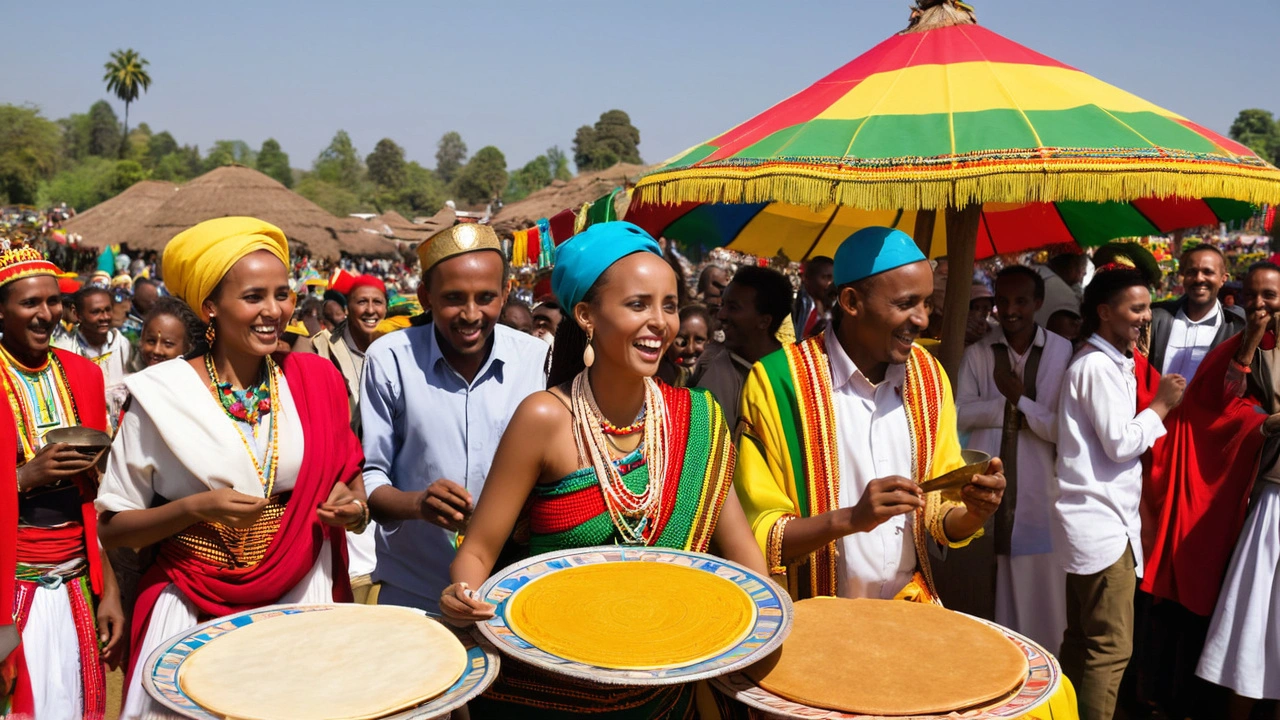Ethiopia is a country filled with a mosaic of cultures, each contributing to the rich tapestry that defines its people. Known for their distinct language, unique cuisine, and vibrant traditions, Ethiopian people carry a deep sense of pride in their heritage. Join us as we delve into the facets that make Ethiopian culture so captivating and timeless.
- Language and Communication
- Cuisine and Culinary Traditions
- Music and Dance
- Festivals and Celebrations
- Historical Achievements
- Art and Craftsmanship
Language and Communication
When it comes to language and communication, Ethiopia is a linguistic treasure trove. The country is home to over 80 ethnic groups, each with its own language or dialect. However, Amharic stands out as the official working language of the federal government. Characterized by its unique script, known as Ge'ez or Fidel, Amharic writing consists of symbols that represent syllables instead of individual letters. This language is not just a means of communication but also a critical link to Ethiopia's past, as ancient texts and literature are preserved in this script.
An interesting aspect of Ethiopian languages is Afaan Oromo, which is spoken by the largest ethnic group, the Oromo people. Oromo is a Cushitic language, and it shares linguistic roots with other languages spoken in the Horn of Africa. Simultaneously, Tigrinya, another predominant language, is used widely in the northern region called Tigray. Both languages use versions of the Ge'ez script, but they have evolved distinct characteristics over the centuries.
Aside from these, Ethiopia is also a melting pot of linguistic traditions. Somali, Sidamo, Wolaytta, and several other languages contribute to the country's rich linguistic diversity. A remarkable fact is that Ethiopia has managed to maintain its indigenous languages despite colonial pressures. To promote cultural coherence and mutual respect, educational reforms have been implemented to teach students in their mother tongues during the early years of schooling.
“Language is the roadmap of a culture. It tells you where its people come from and where they are going.” – Rita Mae Brown
Technology has also played a role in preserving and spreading Ethiopian languages. Digital platforms and social media have become vital tools where Ethiopian youths express themselves in their native tongues, ensuring that the linguistic heritage remains vibrant and relevant. Mobile applications focusing on language learning have gained traction, allowing younger generations to reconnect with their roots more easily.
Moreover, body language, eye contact, and tone of voice are significant elements of how Ethiopians communicate. Politeness and respect are highly valued, and it's common to use honorifics when addressing elders or superiors. This respect for age and authority permeates daily interactions and is evident in traditional greetings, which often include a handshake accompanied by a bow or a kiss on the cheek, depending on the relationship between individuals.
Cuisine and Culinary Traditions
The culinary landscape of Ethiopia is not only diverse but vibrantly rich in flavors and tradition. One of the most iconic elements is injera, a spongy, sourdough flatbread used as both a vessel and accompaniment for a variety of stews and dishes. For the uninitiated, injera serves as the plate, fork, and spoon, making for a truly communal and tactile eating experience.
Ethiopian cuisine is renowned for its array of spicy stews called wats and the more mild alichas. These stews often feature a central protein such as beef, chicken, lamb, or lentils, simmered with a delightful blend of spices. Berbere, a cornerstone spice mix, is typically made from chili peppers, garlic, ginger, basil, and Ethiopian spices like korarima, rue, and ajwain. Its complex layers of heat and flavor provide a unique taste that distinguishes Ethiopian food from any other.
For those with a preference for finger food, the sambusa is an Ethiopian take on the more globally known samosa. These savory pastries are usually filled with lentils or minced meat, making for an excellent snack or appetizer. The attention to flavor and texture makes each bite memorable.
The national dish, doro wat, is a spicy chicken stew featuring berbere and is traditionally served with hard-boiled eggs for special occasions. Cooking doro wat is a labor of love, often taking several hours to reach its full depth of flavor. This dish’s complexity and richness make it a cornerstone at major festivities.
According to Genet Agonafer, a celebrated Ethiopian chef: “Ethiopian food is not just about the ingredients. It's a cultural experience that brings people together, shaped by centuries of tradition.”
If you're in the mood for something lighter, kitfo is a feast for the senses. This dish, often compared to steak tartare, consists of raw minced beef seasoned with mitmita, a potent chili powder. It's usually served with a side of collard greens or soft cheese. Kitfo can also be lightly cooked if raw meat isn't your preference.
Ethiopian cuisine wouldn't be complete without mentioning the traditional coffee ceremony, an integral part of social and cultural life. Coffee, or buna, is freshly roasted, ground, and brewed in a special pot called a jebena. This slow, deliberate process, enjoyed in the company of friends and family, goes well beyond the act of mere consumption, embodying a sense of hospitality and respect. In fact, Ethiopia is considered the birthplace of coffee, dating as far back as the 9th century when it was said to have been discovered by a goat herder named Kaldi.
Tibs are another popular Ethiopian dish that feature sautéed meat cubes seasoned with rosemary, garlic, and other spices. Often served on a sizzling platter, tibs can be enjoyed with a variety of sides such as injera and vegetables. The dish represents the versatility and flavor depth of Ethiopian culinary practices.
Whether you're savoring injera at a communal meal, dipping a sambusa in a spicy sauce, or participating in a coffee ceremony, Ethiopian cuisine offers more than just a meal. It presents a rich tapestry of history, community, and tradition through every dish.

Music and Dance
When you think of Ethiopia, it is impossible not to envision the pulsing rhythms and graceful movements that characterize its traditional music and dance. These cultural expressions are more than mere entertainment; they are essential components of Ethiopian identity, encompassing centuries of history and storytelling.
One of the most iconic elements of Ethiopian music is the use of the krar, a traditional six-stringed lyre. This instrument, along with the masenqo, a one-stringed fiddle, forms the backbone of many Ethiopian musical compositions. Unlike Western music, Ethiopian tunes often employ a pentatonic scale, creating a unique and easily recognizable sound. Renowned Ethiopian singer Tilahun Gessesse once noted, "Ethiopian music is a mirror reflecting the soul of our people."
Dance, too, holds a prominent place in Ethiopian culture, with each ethnic group having its own distinctive style. The eskista, for example, is a dance that involves rapid shoulder movements and is widely performed among the Amhara people. In contrast, the Tigray region boasts dances characterized by intricate footwork and vibrant jumps. These dances are often performed at festivals, weddings, and other significant social gatherings, symbolizing joy and communal unity.
One of the most exhilarating times to experience Ethiopian music and dance is during the celebration of Meskel, the finding of the True Cross. This festival, often held in September, sees communities come together to sing, dance, and light massive bonfires. Performers dressed in colorful traditional attire bring ancient stories to life through their movements and melodies, engulfing spectators in a wave of cultural pride.
Modern Ethiopian music has also evolved, incorporating elements from contemporary genres while still retaining traditional sounds. Artists like Teddy Afro have gained international acclaim for their ability to blend reggae, jazz, and pop with Ethiopian rhythms. Such fusion not only captivates a global audience but also honors Ethiopia's rich musical heritage.
The significance of Ethiopian music and dance in social and spiritual life cannot be overstated. Whether during religious ceremonies, harvest festivals, or even political rallies, the beats of drums and the sways of dancers echo a collective rhythm that binds Ethiopians together. This vibrant culture remains a testament to the enduring spirit of the Ethiopian people.
Historical Achievements
The history of Ethiopia is rich with remarkable achievements that have left an indelible mark on the world. One of the most significant milestones in Ethiopian history is its status as one of the oldest nations in the world. The country has traces of human habitation dating back to prehistoric times, with the discovery of 'Lucy,' a 3.2 million-year-old hominid skeleton, which showcased Ethiopia as a cradle of humanity.
Another extraordinary achievement is that Ethiopia is one of the few African countries never to have been colonized, despite attempts by various foreign powers. This sense of unbroken sovereignty is a profound source of pride for Ethiopians. The Battle of Adwa in 1896 is a testament to this resilience, where Ethiopian forces led by Emperor Menelik II defeated the Italian army, thwarting Italy's attempts to colonize the country. This victory resonated across Africa and the world, symbolizing the strength and determination of African nations to maintain their independence.
During the medieval period, the Aksumite Empire was a key player in international trade and political alliances, connecting the Roman Empire and ancient India. The Kingdom of Aksum, established around 100 AD, was one of the four great powers of its time, alongside Rome, Persia, and China. The Aksumite civilization brought significant advancements in architecture, most notably the famous stelae, and was one of the earliest adopters of Christianity. King Ezana, who converted to Christianity in the 4th century, made Ethiopia one of the first Christian nations in the world.
The Solomonic Dynasty is another crucial chapter in the historical narration of the country. Claiming descent from the biblical King Solomon and the Queen of Sheba, this line of rulers strategically utilized their heritage to consolidate power and foster unity among the people. Empress Zewditu and Emperor Haile Selassie played pivotal roles during their reigns, with Haile Selassie being a key figure in the foundation of the United Nations and the Organization of African Unity.
In the realm of literature and scholarship, Ethiopia produced the Kebra Nagast, an epic narrative that has profoundly influenced Ethiopian civilization and its spiritual life. Written in Ge'ez, the ancient liturgical language, the Kebra Nagast is a cornerstone of Ethiopian Christian history, recounting the story of the Ark of the Covenant's entrance into Ethiopia, among various other biblical and historical narratives.
The architectural marvels of Lalibela are another aspect of Ethiopia's historical achievements. The rock-hewn churches of Lalibela, carved from solid stone in the 12th century, are an unparalleled achievement in architectural history. They serve as an enduring symbol of devotion and craftsmanship, attracting pilgrims and tourists from around the globe.
Ethiopia's history is not only about its grand past but also its continuous evolution. Modern Ethiopia continues to thrive, building on the legacy of its ancestors while forging new paths in science, arts, and global diplomacy. The nation's resilience and innovation continue to inspire people worldwide, from advancements in coffee cultivation to landmark achievements in athletics and long-distance running.

Art and Craftsmanship
Art and craftsmanship in Ethiopia are deeply rooted in the country's rich history and cultural traditions. From the intricate designs of traditional textiles to the remarkable architecture of ancient churches, Ethiopian art is a vibrant expression of the people's identity and heritage. The appreciation for art is evident in their daily lives, with many Ethiopian households adorned with handwoven baskets, pottery, and tapestries that tell stories of generations past.
Ethiopian art is not only about aesthetics but also functionality. The vibrant, handwoven baskets known as jebena are prime examples. These baskets, often used to store and serve food, showcase intricate patterns and vibrant colors. The process of making these baskets is labor-intensive, requiring a high level of skill and patience. The designs are often passed down through generations, with each family adding their unique touch, thus preserving their ancestry and history.
Another significant aspect of Ethiopian craftsmanship is the traditional pottery. Ethiopian potters, often women, use age-old techniques to create functional and decorative items. These potters, using only their hands and a few basic tools, shape the clay into various forms, from cooking pots to coffee cups. The pottery is then fired in an open flame, a method that has remained unchanged for centuries. The resulting pieces are not only utilitarian but also reflect the artistic flair of their creators.
The art of weaving is another important tradition in Ethiopia. Ethiopian weavers create stunning textiles using techniques that have been unchanged for centuries. The shemma, a traditional Ethiopian garment, is a prime example. Woven from cotton, it is adorned with intricate patterns and designs that hold cultural significance. The motifs used often tell stories or represent the wearer's status and identity. As with basket weaving, the skills required for this craft are passed down through generations, ensuring the continuity of this vital cultural practice.
"The art and craft of Ethiopia are more than creative expressions; they are the heartbeat of the nation, a link to our ancestors," says renowned Ethiopian artist, Tadesse Mamecha.
The country's rich architectural heritage is another testament to the remarkable craftsmanship of Ethiopian people. The rock-hewn churches of Lalibela, for example, are a marvel of engineering and artistry. Carved directly into the rock, these ancient structures were created without modern tools, relying solely on the skill and ingenuity of the craftsmen. These churches, some dating back to the 12th century, are still in use today and attract visitors from around the world, eager to witness their grandeur.
Traditional Ethiopian jewelry is another aspect of their craftsmanship that stands out. Made from materials such as gold, silver, and beads, these pieces often carry significant cultural and spiritual meanings. The designs, which include intricate patterns and symbols, are unique to various regions and communities. These jewelry pieces are worn during special occasions and ceremonies, serving as symbols of cultural pride and identity.
In recent years, there has been a resurgence in the appreciation for traditional Ethiopian art and craftsmanship. Contemporary artists and designers are drawing inspiration from these traditional practices, creating modern interpretations that honor their heritage. This blend of old and new is helping to keep these ancient crafts alive, ensuring they continue to be a vital part of Ethiopian culture.
The craftsmanship of the Ethiopian people is a testament to their creativity, resilience, and deep connection to their history and culture. These artistic traditions not only contribute to the beauty of Ethiopian life but also serve as a powerful reminder of the importance of preserving and honoring one's cultural heritage.

 Is Ethiopia a Low Income Country? An In-Depth Look at Ethiopia's Economy
Is Ethiopia a Low Income Country? An In-Depth Look at Ethiopia's Economy
 Understanding Daily Occupations: Insights and Tips
Understanding Daily Occupations: Insights and Tips
 How Much Does a Decent Apartment Cost in Ethiopia?
How Much Does a Decent Apartment Cost in Ethiopia?
 Is Ethiopia One of the Poorest Countries in Africa? Exploring Economic Realities
Is Ethiopia One of the Poorest Countries in Africa? Exploring Economic Realities
 Average Monthly Income in Ethiopia: A Detailed Analysis
Average Monthly Income in Ethiopia: A Detailed Analysis
Chirag P
July 22, 2024 AT 17:40I really appreciate how the piece highlights Ethiopia’s linguistic mosaic. The fact that over 80 languages coexist is impressive. It’s also great to see Amharic’s unique script getting the spotlight. Preserving mother‑tongue education shows genuine respect for cultural roots. Keep sharing these stories.
RUBEN INGA NUÑEZ
July 29, 2024 AT 16:20Your article is factually accurate but the punctuation could use a semicolon instead of a comma.
Michelle Warren
August 5, 2024 AT 15:00Man, this write‑up is a solid deep‑dive but i can’t help noticing a few things that could be sharper. First off the spelling of “injera” gets tossed around like it’s a typo – it’s not. Also the coffee ceremony description feels a bit generic, like you’re just repeating the same old tourist blab. The section on music could have mentioned the krar more-yeah it’s a lyre, but the sound is legit magical. Overall, good effort but a bit more polish would make it pop.
Christopher Boles
August 12, 2024 AT 13:40Love the optimism in this overview! The way you describe the communal aspect of eating injera really captures Ethiopian hospitality. Highlighting the coffee ceremony as more than a drink is spot‑on. Your coverage of historic achievements like the Battle of Adwa adds depth. Thanks for celebrating such a vibrant culture.
Crystal Novotny
August 19, 2024 AT 12:20The narrative you offered feels like a tapestry woven from threads of pride and nostalgia. Each section tries to honor a different facet of Ethiopian life. Yet there is an undercurrent of romanticization that can blur reality. You paint language as a pure relic untouched by modernity. In fact languages evolve just like any living organism. The cuisine, while delicious, is also an economic engine for many families. The coffee ceremony, though sacred, has become a commodity in tourism circuits. Music and dance serve both spiritual and commercial purposes in urban venues. Historical victories like Adwa are rightly celebrated but also used as political symbols today. Artisanal crafts are beautiful but often produced under precarious labor conditions. The rock‑hewn churches stand as marvels but also attract massive foot traffic that threatens preservation. Modern Ethiopian athletes dominate long‑distance races yet their stories are rarely told beyond medals. A balanced view would acknowledge both triumphs and challenges. Your article could benefit from more nuance in these areas. Still, the enthusiasm you bring is contagious and invites readers to explore further.
Reagan Traphagen
August 26, 2024 AT 11:00Everyone else is glorifying Ethiopia while ignoring the hidden agendas of Western NGOs funding cultural projects. They’re just soft‑power tools to control the narrative.
mark sweeney
September 2, 2024 AT 09:40Whoa hold up that’s a wild claim and there’s no solid proof i’ve seen. Sure some funding exists but it’s not a secret mind‑control scheme. We should keep critiquing without jumping to conspiracies. Let’s stick to facts.
randy mcgrath
September 9, 2024 AT 08:20Reading through the different perspectives reminds me that culture is a living conversation between past and present. Each tradition you mentioned is a thread that weaves the larger story of Ethiopia. Thanks for opening this dialogue.